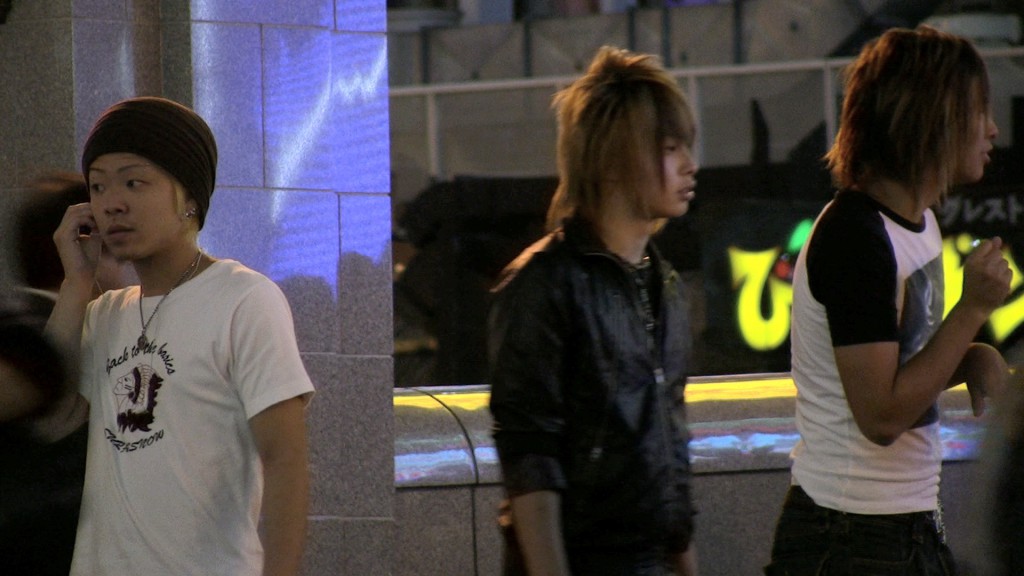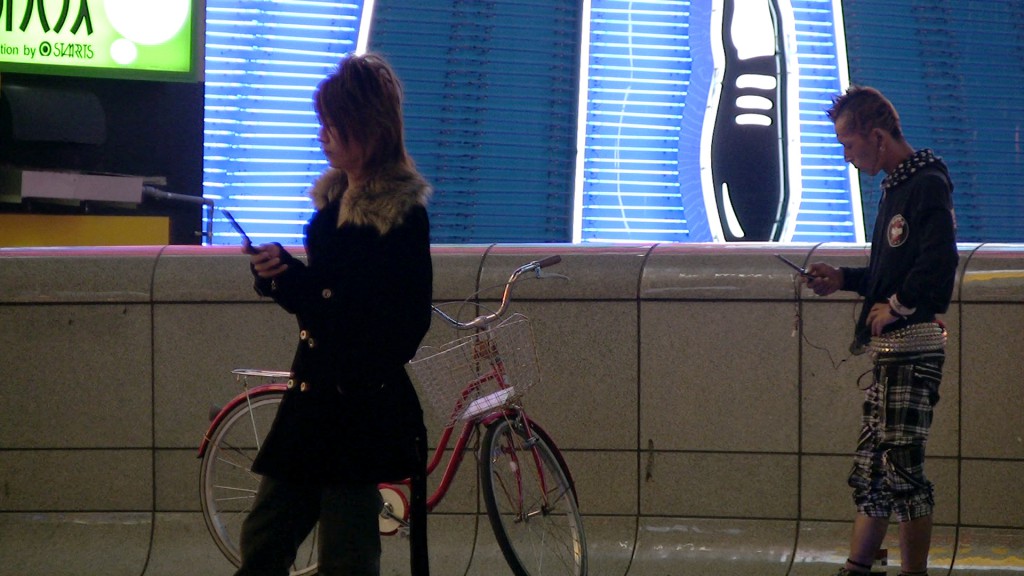Japan / Germany 2008 / 2009 · Single-Channel Video and 3-Channel Video Installation
HD-Video · Color · Sound · 16:9 · 8’25” and 23’50”
Osaka, Ebisu-Bashi Bridge – hot spot and lively center of the inner-city shopping and nightlife district. Groups of tourists taking photos, couples and families shopping and business people on their way home shove their way over the brightly colored bridge lined by electronic billboards and huge neon signs. Due to its central location and the famous Glico Man – Osaka’s well-known neon billboard – the bridge has become a popular meeting place for tourists, youngsters and revelers.
The work shows three different, yet fixed perspectives of the bridge. In the first shot we can observe three buddhist monks standing at the side of the bridge, who are again and again covered by tourists photographing each other in front of the Glico Man (not visible to the viewer). Their monotonous singing and the rhythmic sound of the tone wood blend with the hustle and bustle of the big city and create an extremely big contrast to the seemingly over-excited metropolitan buying frenzy.

The following two perspectives – also subjected to the sound of the monk performance – initially display a group of young men standing by the side of the bridge in stylish, striking outfits. They deliberately approach women to invite them to a karaoke bar or for coffee. This way to pick-up girls – called “Nampa” in Japanese – gives the bridge its nickname “Nampa Bridge”.
The last shot then shows an obviously drugged punk, who – completely into himself and the music he is listening to over his headphones – is giving his own trance-like performance.
Depending on the presentation setting, the work can be shown as a single-channel, short film-like video projection, where the three above described shots are shown as short sequences, successively following one another. In addition, there is a three-channel version of the work designed for the exhibition room, where considerably longer sequences of the three images are projected next to one another and therefore in a simultaneous manner.

Osaka, Ebisu-Bashi Brücke, Hot-Spot und quirliges Zentrum des innenstädtischen Shopping- und Vergnügungsviertels. Gruppen fotografierender Touristen, Pärchen und Familien beim Einkaufsbummel und Geschäftsleute auf dem Nachhauseweg schieben sich massenweise über die von bunten Lichtern, Reklametafeln und Großbildmonitoren gesäumte Brücke. Aufgrund der zentralen Lage und der Bekanntheit des Glico-Manns, der berühmten Leuchtreklame Osakas, wurde die Brücke zum Treffpunkt für Touristen, Jugendliche und Nachtschwärmer.
Die Arbeit zeigt drei verschiedene, gleich bleibende Perspektiven auf die Brücke. In der ersten Einstellung sehen wir drei buddhistische Mönche, die am Brückenrand stehen und immer wieder von Touristen verdeckt werden, die sich gegenseitig vor dem (im Bild nicht sichtbaren) Glico-Mann fotografieren. Ihr monotoner Gesang und der rhythmische Ton der Klanghölzer mischen sich in den Lärm des Großstadttreibens und bilden einen denkbar großen Kontrast zum überdreht wirkenden Konsumrausch der Metropole.

Die folgenden beiden Einstellungen, denen ebenfalls der Klang der Mönchsdarbietung unterliegt, zeigen zunächst eine Gruppe am Brückenrand stehender junger Männer in modischen, auffällig gestylten Outfits. Sie sprechen gezielt Frauen an, um sie zu Karaoke oder Kaffee einzuladen. Diese im Japanischen als „Nampa“ bezeichnete Form der Anmache gibt der Brücke ihrer Spitznamen „Nampa Bridge“.
Das letzte Bild schließlich zeigt einen offensichtlich unter Drogen stehenden Punk, der völlig mit sich selbst beschäftigt zur Musik aus seinen Kopfhörern seine ganz eigene, tranceartige Vorstellung abgibt.
Abhängig von der Präsentationssituation kann die Arbeit einmal als einkanalige, kurzfilmartige Videoprojektion gezeigt werden, bei der die drei oben beschriebenen Einstellungen als kurze Sequenzen sukzessive aufeinander folgen. Darüber hinaus gibt es eine für den Ausstellungsraum konzipierte 3-Kanal-Version der Arbeit, bei der deutlich längere Sequenzen der drei Bilder nebeneinander und somit gleichzeitig projiziert werden.
© 2009 Martin Brand